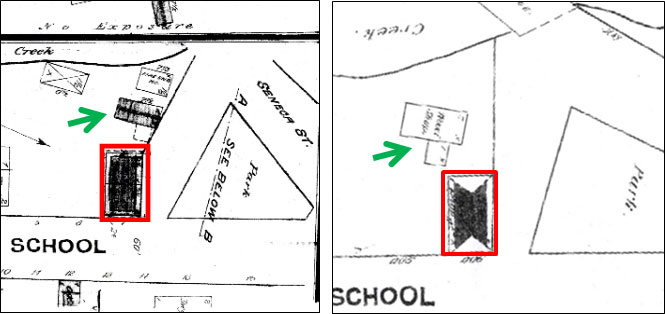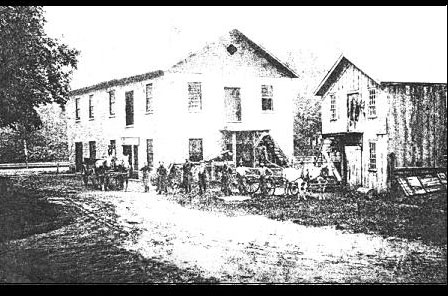The Town of Sullivan was chartered in 1803 and named for the General who campaigned against the Native Americans in 1779. Chittenango was not officially organized as a Village until 1842, though European settlement began in the early years of the nineteenth century. One of the most prominent figures in Chittenango's early history was John B. Yates, Esq. Yates eventually owned most of the land in the area now known as Chittenango, and was responsible for much of the community's early industrial and economic development. Among his more notable contributions was the development of the Yates Polytechnic Institute and the community's first cotton mill. It is likely that he also built the stone blacksmith shop, though archival evidence for this is minimal. A short column in an 1894 issue of the Madison County Times predicted the imminent destruction of the "Old Stone Shop," which was reputedly built "about three quarters of a century ago by the Hon. John B. Yates for a blacksmith and tin shop."
This shop may have been the location where locally quarried water lime was first identified. This discovery was integral to the development of the Erie Canal, which runs through northern Chittenango. According to Hammond (1872), a "scientific gentleman" conducted an experiment in Yates' triphammer shop which proved that the lime could be used to make hydraulic cement. It is not certain that the Old Stone Shop was the location of Yates' triphammer and this momentous discovery, but a list of Yates' properties published some years later shows him owning a single blacksmith and triphammer complex shop (New York State 1830). Maps from the 1850s show that the creek used to branch just south of the park; water power from this branch may have enabled the blacksmith shop to house a triphammer. In the nineteenth century, the blacksmith shop was a gathering place for men who could socialize while waiting for their horses to be shod or their repairs to be completed (Watson 1968). In this context, it is not particularly surprising that the Yates and his gentlemen friends conducted their experiment in the smithy.
Deed records and archival evidence provided by Richard Sullivan, Assistant Chittenango Village Historian, suggest that the shop was operated by a series of unrelated smiths over the course of its existence, many of whom were probably tenants of Yates and later owners. The Madison County Times, Chittenango Herald, and the Chittenango Republican contained occasional references to the business at the blacksmith shop. For example, the files of the Village Historian include the following transcript of an unidentified newspaper notice dated April 13, 1842:
The subscriber [Charles A. Warner] would respectfully give notice, that he has rented the Stone blacksmith shop of George Grant & Co. in this village, where he will be happy at all times to wait upon all persons who will favor him with their Blacksmith work. He will attend to all kinds of country work. Such as Horse shoeing, Wagon and Carriage Ironing, and all kinds of Edge Tools usually manufactured by country blacksmiths; and he pledges himself to the public that he will be prompt in attending to all calls in his line of business. His charges shall be reasonable, and he will take grain and most kinds of country produce in payment for work; Also, when required, he will give credit as is usual for mechanics. He trusts and hopes by persevering, industry and good work to merit and receive a share of the public patronage.

This notice provides an excellent description of the types of work performed by the stone shop’s smiths in the mid-nineteenth century, and suggests that their trade was geared towards the surrounding farms rather than the needs of the villagers or the canal boat operators. Several other blacksmith shops existed in Chittenango and Sullivan, and the canal boat operators could patronize the smith who had set up shop at the Chittenango Landing. After placing the above ad in the paper, Charles Warner formed a partnership with William H. Lewis. This venture was dissolved on September 7, 1843, though Lewis continued the practice “at the old stand” (Chittenango Herald September 13, 1843). Lewis’s solo practice lasted only a month, as an ad published in the Chittenango Republican on October 23, 1843 announced the blacksmithing business of Nicholas Hemstreet and Harvey Seely.
These are the earliest specific references to the blacksmith shop. The owner of the shop at this time was George Grant, and in 1865, he sold two small parcels of land in the vicinity of Stickles Park to John Quincy Adams, a namesake of the former President.
Adams’ association with the stone shop may have begun well before his 1865 purchase. His father, Joseph, was listed as a blacksmith in the 1850 census. It is possible that Adams was renting the stone shop by at least 1859. Supporting this conjecture is the fact that his brother, George, was listed as a wagon maker in the 1860 census. Later maps show that blacksmith shop was paired with a carriage/wagon building establishment in the area now known as Stickles Park.
It is unclear when carriage/wagon manufacturing began to be conducted at the site. The historic maps consistently illustrate the presence of multiple structures in the vicinity of the site, and the 1875 and 1884 maps show that there was a wagon shop located directly west of the stone blacksmith shop. The 1890 Sanborn map lists this structure as a ‘wood shop’, which was described by Richardson (1889) as an outbuilding to a blacksmith shop used to store lumber and other materials used in the manufacture of wagons. Charles Warner’s 1842 newspaper notice suggested that he would provide parts for wagons and carriages, but his successors (Hemstreet and Seely) only specified the production of axes. It is possible that the wagon shop was operated independently of the blacksmith shop during George Grant’s tenure. By the late 1860s, however, these industries were combined into one business owned and operated by John Q. Adams.
Industrial records in the 1875 census show that Adams turned a profit of $840, as opposed to a smaller-scale competitor in the village who earned only $600 in profit. Horse shoeing had become Adams’ most lucrative service, while wagon production earned him comparably less than it did in 1865. This reflects a national trend in the late 1800s, in which rural wagon production began to decline as a result of urban wagon factories employing multiple smiths in an early form of mass production (Gibb 1985). The rural smith’s function in society began to be marginalized as more and more smiths gravitated to the factories.
Adams’ financial situation was apparently not as rosy as the 1875 census records suggest. The stone shop had been mortgaged twice, and in late 1875 he sold the shop to Thomas Wilder. Wilder entered into a partnership with a man named Robinson (possibly Lester A. Robinson, a local blacksmith in the 1860 census), and they apparently specialized in the production of wagons. In the summer of 1876, the Madison County Times invited potential clients to “examine” the new style of lumber wagon produced by Wilder and Robinson. These new wagons may have been local innovations designed to compete with the factory produced wagons of nearby Syracuse. Carriage (and sign) painting services were also available at the stone shop that year, as Charles Berry opened a paint shop on the second story of the building. Despite his brother’s departure from the smithing business, George Adams continued to work on wagon repairs for Wilder and Robinson.
Business boomed for Wilder and Robinson in the spring of 1877, but by 1879 the pair decided to part ways. The March 29 edition of the Madison County Times reported that Wilder and Robinson sold the business to William Case and George Adams; Case was described as an experienced workman and Adams was to continue working as a wagon maker. In addition, Robinson was reportedly planning to stay on under the new ownership. This transaction is not recorded in the county deed books. Instead, Wilder sold the property to a relative, Clarence Wilder, who resold the property two months later to Sarah Walrath. Sarah’s husband, George, had worked with his father and brother at the aforementioned Walrath smithy (Smith 1899). A notice of the new ownership in the Madison County Times stated that:
Mr. George Walrath, having purchased the stone shop of Thomas Wilder, has taken possession of the same, and is making needed improvements. He will soon place a steam engine in the shop, and carry on a general repairing business, in connection with his blacksmithing and carriage making.
These accounts describe another shift in the function of the blacksmith shop, as Walrath seemed to be scaling back the production of tools and horse shoeing in favor of repairs and retail. This again follows national trends in blacksmithing at the time. As a greater number of metal items began being mass produced in cities, smiths found it difficult or impossible to repair these items. Instead, rural blacksmith shops contracted with the urban factories to stock their parts so they could maintain certain manufacturers’ wagons and equipment (Gibb 1985). This, in effect, made the blacksmith more of a mechanic than an artisan. The addition of the steam engine suggests an interest in modernizing the business. While carriage making is mentioned in the second notice, Smith’s 1880 history of Chittenango describes Walrath as a blacksmith and attributes the wagon manufactory to G. Adams. The business was sold again during the 1880s to Octavia Fuller. She proceeded to lease the shop as Yates and Grant before her. Business continued at the Old Stone Shop for about a decade more, during which time the photograph depicted in Figure 4 was taken.

An 1894 column in the Madison County Times stated that the Old Stone Shop was slated for destruction, though it apparently held out for at least one more year. The property was owned at that time by May Fuller, daughter of Octavia. The Fuller family lived across the street (NY 13) from the shop. The 1894 column suggests that May Fuller considered the shop “not particularly useful or attractive,” and thought that the “site and locality will be improved by its removal.” The reporter expressed some wistful sentiment, however, as the structure was also described as an “ancient landmark” and a “part of the past history of the town.” The exact date of the structure’s demolition is uncertain, but it apparently fell between 1895 and 1900.
